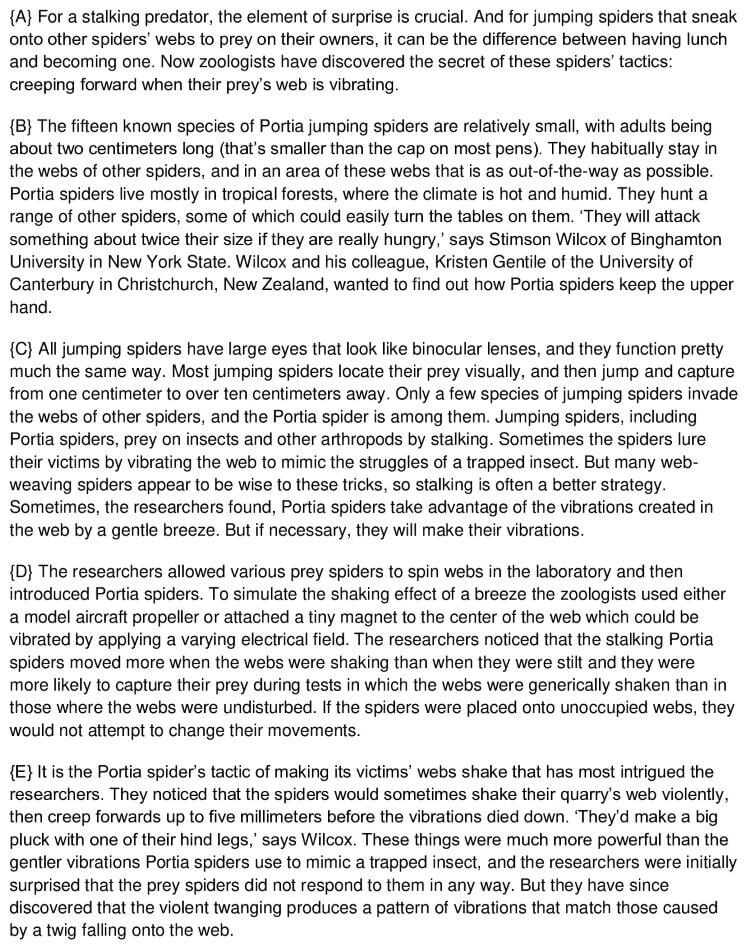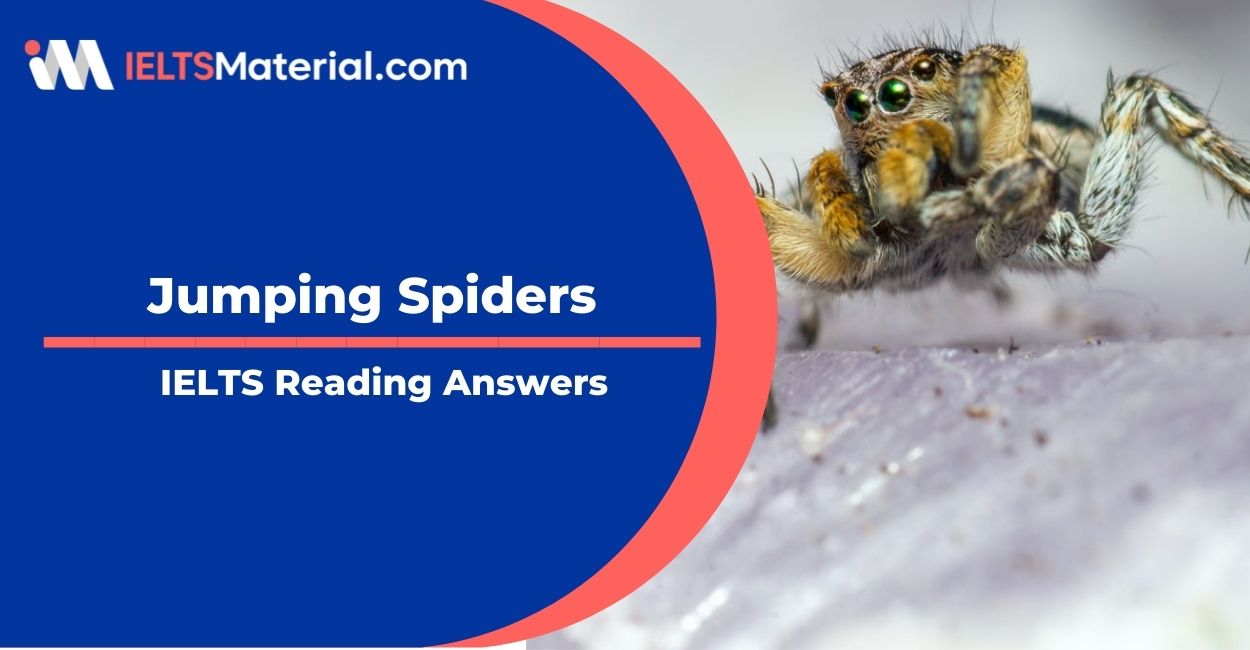Jumping Spiders- IELTS Reading Answers
6 min read
Updated On
-
Copy link
Table of Contents

Limited-Time Offer : Access a FREE 10-Day IELTS Study Plan!
Reading Passage
Jumping Spiders


Questions 1-9
The IELTSFever Academic IELTS Reading Test 158 Reading Passage has six paragraphs labeled A-F.
Which paragraph contains the following information?
Write the correct letter A-F on your answer sheet.
NB You may use any letter more than once.
1 the reaction of the Portia spider’s prey to strong web vibrations
2 a description of how the researchers set up their experiment
3 a comparison between Portia spiders and other animal species
4 an explanation of how the researchers mimicked natural conditions
5 a comparison between Portia spiders and their prey
6 the reason why concealment is important to Portia spiders
7 a description of the Portia spider’s habitat
8 the number of species of Portia spiders
9 an example of the Portia spider’s cleverness
Questions 10-13
Question 10 In their laboratory experiments, the researchers found that the Portia spiders moved most when the web was
A vibrating.
B motionless.
C undisturbed.
D unoccupied.
Question 11 What discovery did the researchers make about Portia spiders?
A They make very strong vibrations with one leg.
B They move 5 mm at a time on a still web.
C They move slowly when vibrations stop.
D They use energetic vibrations to mimic a trapped insect.
Question 12 Portia spiders are the only known animal to
A use the weather to disguise themselves.
B mimic other prey-eating animals.
C create their smokescreen.
D stalk using ‘trial and error’.
Question 13 The Portia spider demonstrates ‘thinking ahead’ when it
A chooses prey that is a short distance away.
B takes a longer route to reach its prey.
C reaches its prey in a short time.
D solves the problem of locating its prey.
Reading Answers
1 Answer: E
Question type: Matching information
Answer location: Paragraph E, lines 2-9
Answer explanation: “They noticed that the spiders would sometimes shake their quarry’s web violently, then creep forwards up to five millimeters before the vibrations died down. ‘They’d make a big pluck with one of their hind legs,’ says Wilcox. These things were much more powerful than the gentler vibrations Portia spiders use to mimic a trapped insect, and the researchers were initially surprised that the prey spiders did not respond to them in any way. But they have since discovered that the violent twanging produces a pattern of vibrations that match those caused by a twig falling onto the web.” Here it can be easily discerned that the prey of the Portia spiders don’t react when an intense vibration is made by the spiders as they consider it to be a twig falling on their web. Therefore, their response is recorded in paragraph E
2 Answer: D
Question type: Matching information
Answer location: Paragraph D, lines 1-4
Answer explanation: “The researchers allowed various prey spiders to spin webs in the laboratory and then introduced Portia spiders. To simulate the shaking effect of a breeze the zoologists used either a model aircraft propeller or attached a tiny magnet to the center of the web which could be vibrated by applying a varying electrical field.” This suggests how the researchers established the conditions to carry out their study and analysis of Portia spider’s behavior and how they strategize their predation.
3 Answer: F
Question type: Matching information
Answer location: Paragraph F, lines 1-3
Answer explanation: “Other predators make use of natural ‘smokescreens’ or disguise to hide from their prey: lions hunting at night, for example, move in on their prey when clouds obscure the moon.” This draws a line of contrast between the predatory behavior of other animals and the Portia spiders.
4 Answer: D
Question type: Matching information
Answer location: Paragraph D, lines 1-4
Answer explanation: “The researchers allowed various prey spiders to spin webs in the laboratory and then introduced Portia spiders. To simulate the shaking effect of a breeze the zoologists used either a model aircraft propeller or attached a tiny magnet to the center of the web which could be vibrated by applying a varying electrical field.” This suggests that the scientists tried to simulate the natural conditions to analyze the behavior and movements of the Portia spiders.
5 Answer: B
Question type: Matching information
Answer location: Paragraph B, lines 5-9
Answer explanation: “They hunt a range of other spiders, some of which could easily turn the tables on them. ‘They will attack something about twice their size if they are really hungry,’ says Stimson Wilcox of Binghamton University in New York State. Wilcox and his colleague, Kristen Gentile of the University of Canterbury in Christchurch, New Zealand, wanted to find out how Portia spiders keep the upper hand.” By these lines, a clear and transparent comparison between the Portia spiders and their prey is drawn. Hence the reference can be found in Paragraph B.
6 Answer: A
Question type: Matching information
Answer location: Paragraph A, the introductory line
Answer explanation: “For a stalking predator, the element of surprise is crucial.” This suggests that concealing/hiding from their prey is a crucial element for the predators like Portia spiders who often stalk their prey.
7 Answer: B
Question type: Matching information
Answer location: Paragraph B, lines 2-5
Answer explanation: “They habitually stay in the webs of other spiders, and in an area of these webs that is as out-of-the-way as possible. Portia spiders live mostly in tropical forests, where the climate is hot and humid.” These lines render the description of the habitat and inhabiting conditions.
8 Answer: B
Question type: Matching information
Answer location: Paragraph B, lines 1-2
Answer explanation: “The fifteen known species of Portia jumping spiders are relatively small, with adults being about two centimeters long (that’s smaller than the cap on most pens).” These lines give the exact number of the species of Portia spiders, i.e. 15.
9 Answer: F
Question type: Matching information
Answer location: Paragraph F, lines 4-6
Answer explanation: “‘Portia spiders are intelligent and they often learn from their prey as they are trying to capture it. They do this by making different signals on the web of their prey until the prey spider moves.” These lines suggest that the Portia spiders are cunning and astute predators. They show their cunningness in various ways and learning from their prey’s behavior is one among them.
10 Answer: A
Question type: Multiple Choice Question
Answer location: Paragraph D, lines 4-7
Answer explanation: “The researchers noticed that the stalking Portia spiders moved more when the webs were shaking than when they were stilt and they were more likely to capture their prey during tests in which the webs were generically shaken than in those where the webs were undisturbed.” These pimples that the spiders were found to be moving more when the webs were having movements and were moving less when the webs were not shaking/vibrating.
11 Answer: A
Question type: Multiple Choice Question
Answer location: Paragraph E, lines 2-4
Answer explanation: “They noticed that the spiders would sometimes shake their quarry’s web violently, then creep forwards up to five millimeters before the vibrations died down. ‘They’d make a big pluck with one of their hind legs,’ says Wilcox.” These lines suggest the idea that the spiders pluck the web of their prey with their hind legs to dupe/fool their prey.
12 Answer: C
Question type: Multiple Choice Question
Answer location: Paragraph F, lines 1-4
Answer explanation: “Other predators make use of natural ‘smokescreens’ or disguise to hide from their prey: lions hunting at night, for example, move in on their prey when clouds obscure the moon. ‘But this is the first example of an animal making its smokescreen that we know of,’ says Wilcox.” This suggests that the Portia spiders are by far the only animals to be discovered that create a smokescreen to attack their prey.
13 Answer: B
Question type: Multiple Choice Question
Answer location: Paragraph F, lines 9-12
Answer explanation: “Sometimes they will even take an indirect route to reach a prey spider they can see from a distance. This can sometimes take one to two hours following a predetermined route. When it does this, the Portia spider is solving problems and thinking ahead about its actions.’” This suggests that when the spiders are thinking ahead of time they are generally planning an indirect route to reach their prey, even if that route is longer.
Check More IELTS Reading Answers
Practice IELTS Reading based on question types

Start Preparing for IELTS: Get Your 10-Day Study Plan Today!
Recent Articles

Nehasri Ravishenbagam

Haniya Yashfeen

Haniya Yashfeen

Haniya Yashfeen




Post your Comments